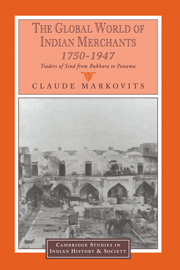Book contents
- Frontmatter
- Contents
- List of maps
- List of tables
- Acknowledgements
- Glossary
- Introduction
- 1 South Asian merchant networks
- 2 The regional context: Sind economy and society, c. 1750–1950
- 3 The Gate of Khorrassan: the Shikarpuri network, c. 1750–1947
- 4 From Kobe to Panama: the Sindworkies of Hyderabad
- 5 Patterns of circulation and business organization in two merchant networks
- 6 The business of the Sind merchants
- 7 The politics of merchant networks
- 8 Community and gender in two merchant networks
- 9 Epilogue: the Sindhi diaspora after 1947
- Conclusion
- Appendices
- Bibliography
- Index
2 - The regional context: Sind economy and society, c. 1750–1950
Published online by Cambridge University Press: 22 October 2009
- Frontmatter
- Contents
- List of maps
- List of tables
- Acknowledgements
- Glossary
- Introduction
- 1 South Asian merchant networks
- 2 The regional context: Sind economy and society, c. 1750–1950
- 3 The Gate of Khorrassan: the Shikarpuri network, c. 1750–1947
- 4 From Kobe to Panama: the Sindworkies of Hyderabad
- 5 Patterns of circulation and business organization in two merchant networks
- 6 The business of the Sind merchants
- 7 The politics of merchant networks
- 8 Community and gender in two merchant networks
- 9 Epilogue: the Sindhi diaspora after 1947
- Conclusion
- Appendices
- Bibliography
- Index
Summary
Sind has been a neglected area in South Asian Studies, because it is a ‘frontier’ area, a transition zone between ‘India proper’ and the vast region which was often called Khorrassan, in which were included southern Afghanistan, Baluchistan and southeastern Iran. Persian cultural influences were strong, and Sind was only episodically included in the great pan-Indian empires. In the late eighteenth and early nineteenth century, under the Sindhi Kalhora and Baluchi Talpur dynasties, it evolved into an original kind of polity, a sort of tribal confederation, which was however capable of overseeing the maintenance and development of one of the largest systems of canal irrigation in Asia centred on the Lower Indus. This Sindhian state was the victim of a particularly vicious propaganda campaign in the wake of the British annexation, in 1843, aimed at presenting it as the epitome of backwardness and tyranny, which, to all appearances, it was not. The fate of the Hindus of Sind was one of the themes most harped upon by Napier and his minions in their attempts at blackening the picture so as to justify the inexcusable ‘piece of rascality’ of which Napier himself cynically boasted. The question of the role of the Hindus, and in particular, of their dominance over commercial life, both in pre-colonial and in colonial times, is therefore of great importance to the emergence of a balanced picture of the history of Sind.
- Type
- Chapter
- Information
- The Global World of Indian Merchants, 1750–1947Traders of Sind from Bukhara to Panama, pp. 32 - 56Publisher: Cambridge University PressPrint publication year: 2000



